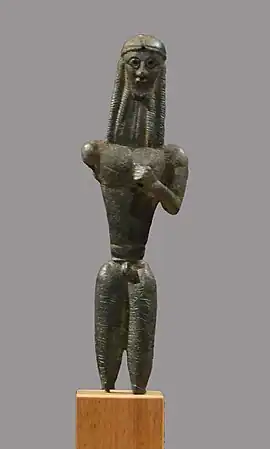| Mantiklos "Apollo" | |
|---|---|
 | |
| Year | c. 700-675 B.C. |
| Medium | Bronze |
| Subject | Male figure |
| Dimensions | 20.3 cm (8.0 in) |
| Location | Museum of Fine Arts, Boston |
| Accession | 03.997 |
The Mantiklos "Apollo" is an ancient Greek sculpture from the early Archaic period. The sculpture dates to about 700-675 B.C from Thebes and measures 20.3 cm tall. It is on display at the Museum of Fine Arts, Boston.[1]
Description
The sculpture, per the inscription on its thighs, is an offering to the god Apollo from Mantiklos. It is unclear whether the sculpture is meant to represent Mantiklos or Apollo. The sculpture's right arm is now lost; if the sculpture's right arm held a shield and spear, it would indicate that the sculpture represents Mantiklos, whereas a bow and arrow would indicate it represents Apollo.[1]
The sculpture is significant for representing a transition from daedalic sculpture to more natural forms.[1][2]
References
- 1 2 3 "Mantiklos "Apollo"". Museum of Fine Arts, Boston. Retrieved 30 Aug 2023.
- ↑ Biers, William R. "Mantiklos Figurine". Joukowsky Institute for Archaeology. Brown University. Retrieved 2023-08-30.
Further reading
- Shakeshaft, Hugo (2022). Beauty, Gods, and Early Greek Art: The Dedications of Mantiklos and Nikandre Revisited. The Art Bulletin, https://doi.org/10.1080/00043079.2022.2000268
- Mitten, David Gordon (1967). The Earliest Greek Sculptures in the Museum. Boston Museum Bulletin, http://www.jstor.org/stable/4171466
This article is issued from Wikipedia. The text is licensed under Creative Commons - Attribution - Sharealike. Additional terms may apply for the media files.